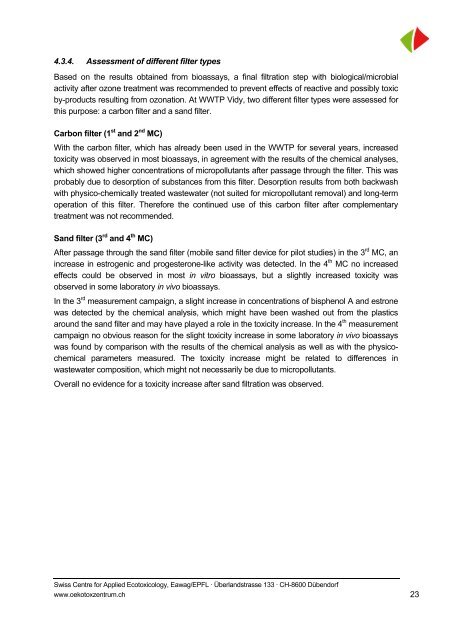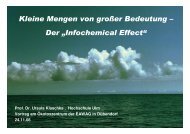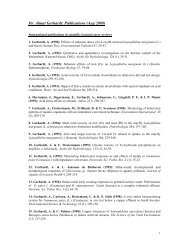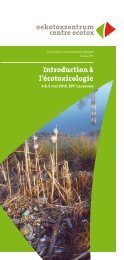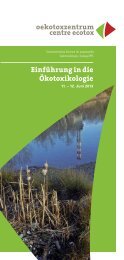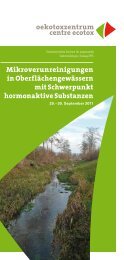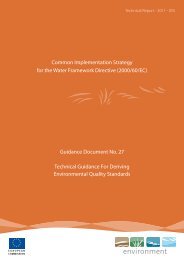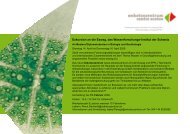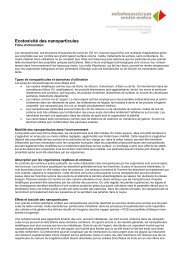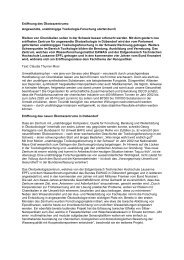Evaluation of Bioassays and Wastewater Quality ... - Oekotoxzentrum
Evaluation of Bioassays and Wastewater Quality ... - Oekotoxzentrum
Evaluation of Bioassays and Wastewater Quality ... - Oekotoxzentrum
You also want an ePaper? Increase the reach of your titles
YUMPU automatically turns print PDFs into web optimized ePapers that Google loves.
4.3.4. Assessment <strong>of</strong> different filter types<br />
Based on the results obtained from bioassays, a final filtration step with biological/microbial<br />
activity after ozone treatment was recommended to prevent effects <strong>of</strong> reactive <strong>and</strong> possibly toxic<br />
by-products resulting from ozonation. At WWTP Vidy, two different filter types were assessed for<br />
this purpose: a carbon filter <strong>and</strong> a s<strong>and</strong> filter.<br />
Carbon filter (1 st <strong>and</strong> 2 nd MC)<br />
With the carbon filter, which has already been used in the WWTP for several years, increased<br />
toxicity was observed in most bioassays, in agreement with the results <strong>of</strong> the chemical analyses,<br />
which showed higher concentrations <strong>of</strong> micropollutants after passage through the filter. This was<br />
probably due to desorption <strong>of</strong> substances from this filter. Desorption results from both backwash<br />
with physico-chemically treated wastewater (not suited for micropollutant removal) <strong>and</strong> long-term<br />
operation <strong>of</strong> this filter. Therefore the continued use <strong>of</strong> this carbon filter after complementary<br />
treatment was not recommended.<br />
S<strong>and</strong> filter (3 rd <strong>and</strong> 4 th MC)<br />
After passage through the s<strong>and</strong> filter (mobile s<strong>and</strong> filter device for pilot studies) in the 3 rd MC, an<br />
increase in estrogenic <strong>and</strong> progesterone-like activity was detected. In the 4 th MC no increased<br />
effects could be observed in most in vitro bioassays, but a slightly increased toxicity was<br />
observed in some laboratory in vivo bioassays.<br />
In the 3 rd measurement campaign, a slight increase in concentrations <strong>of</strong> bisphenol A <strong>and</strong> estrone<br />
was detected by the chemical analysis, which might have been washed out from the plastics<br />
around the s<strong>and</strong> filter <strong>and</strong> may have played a role in the toxicity increase. In the 4 th measurement<br />
campaign no obvious reason for the slight toxicity increase in some laboratory in vivo bioassays<br />
was found by comparison with the results <strong>of</strong> the chemical analysis as well as with the physicochemical<br />
parameters measured. The toxicity increase might be related to differences in<br />
wastewater composition, which might not necessarily be due to micropollutants.<br />
Overall no evidence for a toxicity increase after s<strong>and</strong> filtration was observed.<br />
Swiss Centre for Applied Ecotoxicology, Eawag/EPFL · Überl<strong>and</strong>strasse 133 · CH-8600 Dübendorf<br />
www.oekotoxzentrum.ch<br />
23


